|
Getting your Trinity Audio player ready...
|
With thousands of mountains in the state, Colorado has developed a reputation as an outdoor paradise in all four seasons. The average elevation is the highest of any state in the USA, including Alaska, and Colorado boasts millions of acres of public land. It is because of the state’s unique geography that it’s possible to ski any month of the year.
In 2021, I decided to join the ranks and accelerate my burgeoning love of backcountry skiing by skiing every month of the year. To date, I’ve skied for more than a year and plan on going for at least 30 months. Below are some observations, facts, and information that I think will be helpful for the next wave of enthusiasts ready to tackle this strange, wonderful, and difficult outdoor challenge.
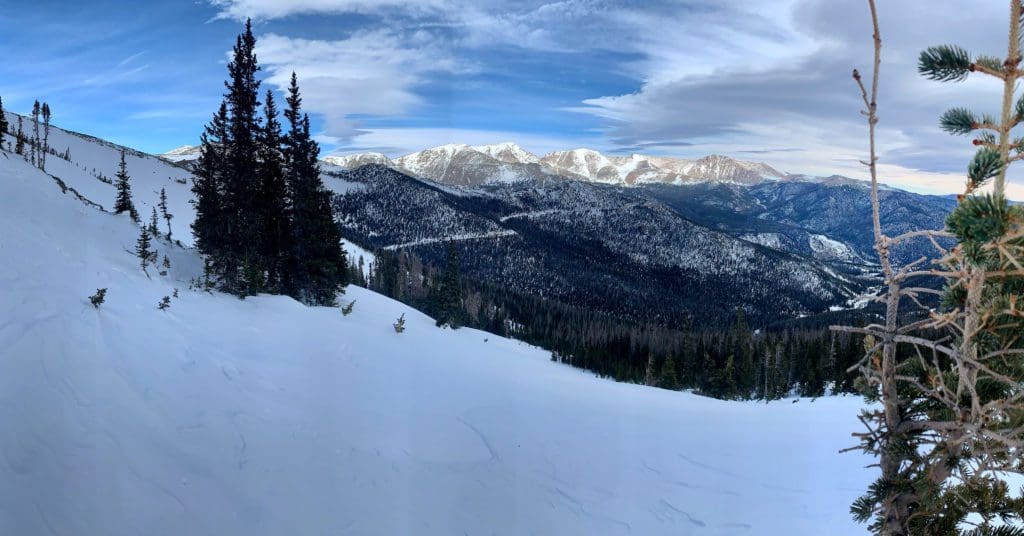
Hidden Valley backcountry ski area in Rocky Mountain National Park.
Table of Contents
Article Navigation: Click on any of the listed items in the table of contents below to jump to that section of the article. Similarly, clicking on any large, white section header will jump you back to the Table of Contents.
- Challenge Details
- Backcountry Resources and Information
- Resorts Analysis (Snowfall averages, opening dates, and closing dates)
- Snowpack Stabilization and the Backcountry
- Popular Springtime Backcountry Areas (April-June)
- Summer Skiing
- Autumn Skiing
- Tips and Tricks for Fee Areas
- Why would anyone do this?
- Final Thoughts
- Additional Resources
Challenge Details
A lot of what you get out of this type of challenge revolves around what you put into it. There isn’t really a standard way to do it aside from skiing every month, so a lot of creativity can be put into what is essentially a challenge of your own making. You also aren’t limited to Colorado, you can take trips all over the world to chase powder, but for most of us, that isn’t possible. Rest assured, you find snow all year in the centennial state.
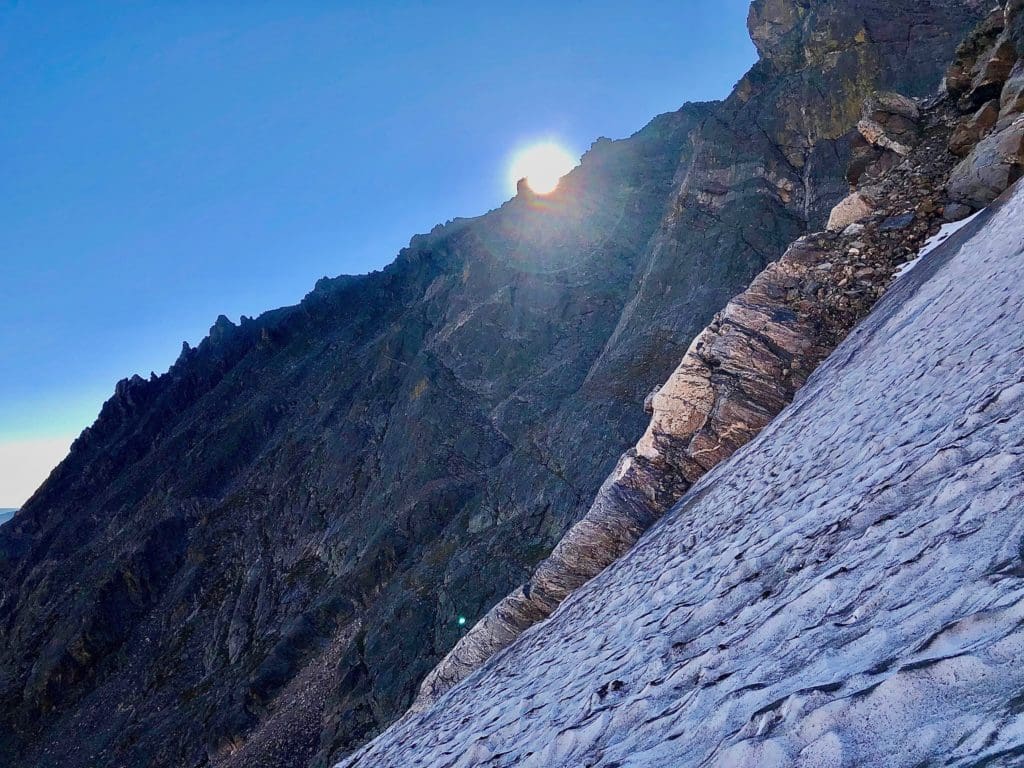
Late August snow near Ptarmigan Glacier.
Personally, I settled on a few criteria based on my decades of outdoor recreation, resort skiing, seven years of ski instructing, and blossoming love for backcountry skiing.
- One ski adventure every month w/ a minimum of 5 connected turns
- During snowy months (~Dec-May), I can ski one backcountry mountain a few times, provided each line is different. Different, in this case, means separated by logical topographical considerations, i.e., different faces, drainages, couloirs, glades, or ridges separated by rocks, trees, creeks, highways, etc. For example, I wouldn’t be able to ski 20 feet to either side of a previous line and call it different.
- During non-snowy months, I cannot repeat a glacier or permanent snowfield and have it count twice.
- I will allow myself two side-country runs a year (where you can access a non-patrolled route from a patrolled ski area), but they are not mandatory.
- Essentially, earn my turns for as many months as I can string together without repeating the same ski lines.
- Bonus objective: ski at least 2-3 backcountry lines from Dec.-May.
Again, this is not the only way to do this, and, in fact, might be one of the harder methods because I wanted to focus exclusively on backcountry skiing. However, if you want to ease the backcountry burden, rest assured you can find consistent resort skiing from November through May. On good years, some high elevation resorts open in October and close in June. By leaning heavily on resorts, you only have to hunt for snowfields from July to mid-October.
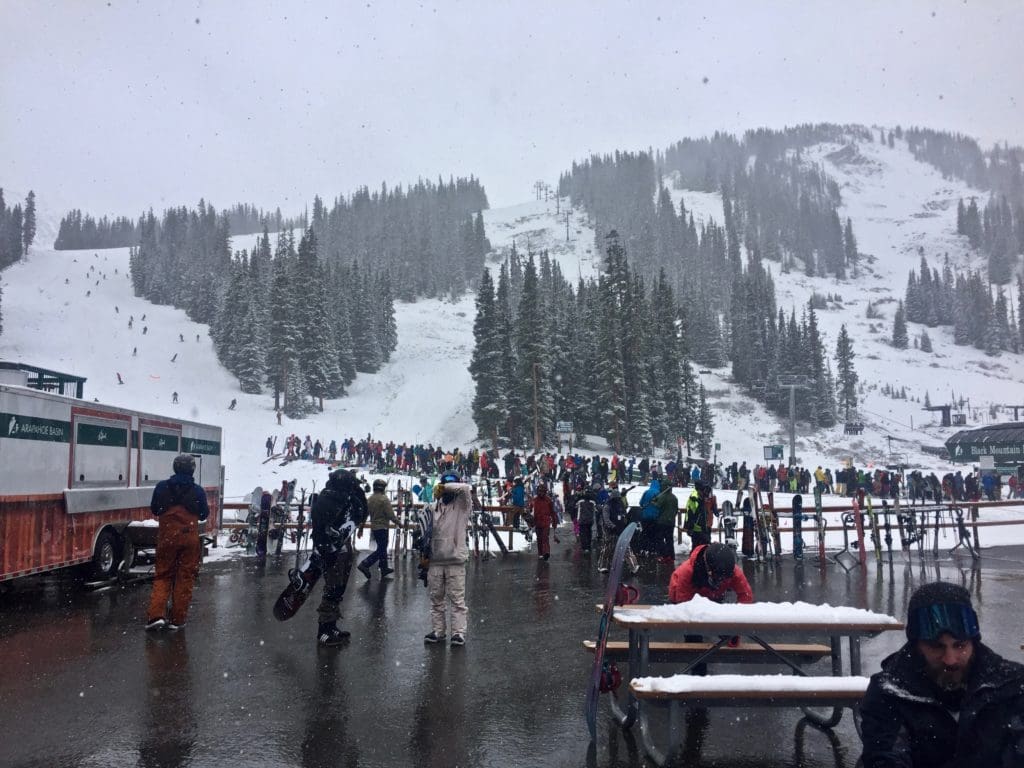
A-Basin on June 23, 2019; they stayed open until July 4th that year.
Another factor I stacked against myself was a focus on avoiding repetition. If you couple resort skiing with the ability to repeat lines in the summer, you can make the challenge quite manageable. Seeing as this is Colorado, where nearly 60 peaks rise above 14,000 feet in elevation, you can find an alpine glacier or permanent snowfield and ride that through the summer to satisfy the challenge.
The gist is quite simple, ski all year; the details are up to you. The open-ended nature of the challenge makes it quite unique and allows for a lot of personal creativity (and ultimately honesty) to report and adhere to your own standards.
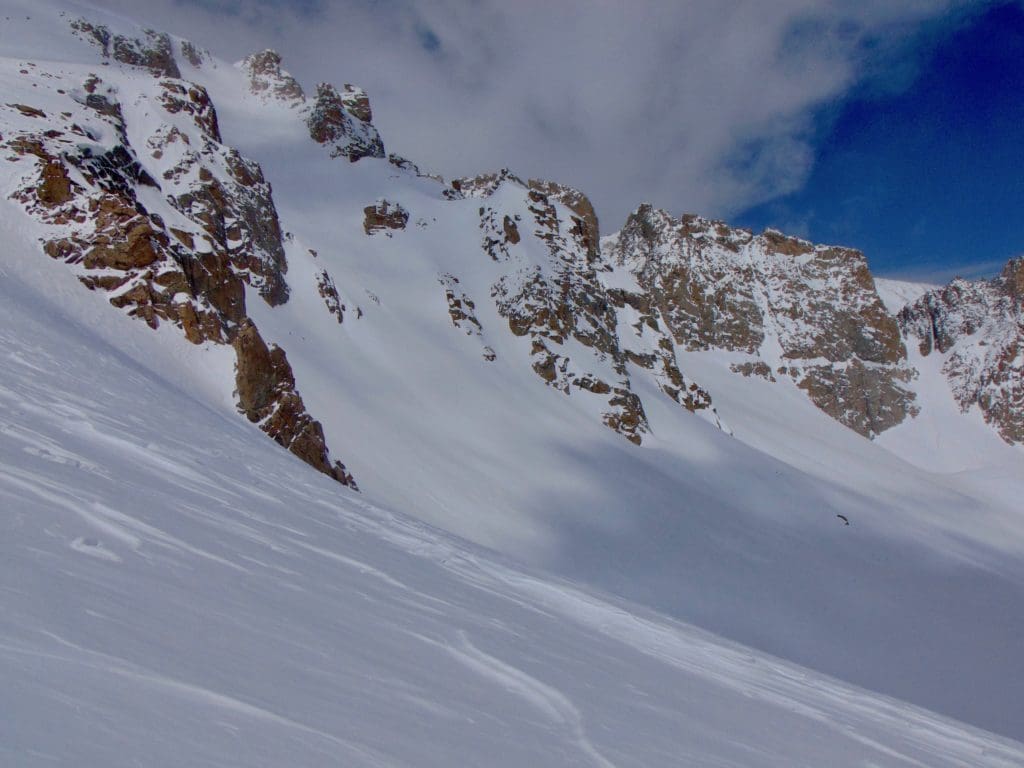
Smooth snow after a late March snow storm in the Indian Peaks Wilderness.
Backcountry Resources and Information
Even if you manage to resort ski from October-June and repeat a reliable snowfield through the rest of the year, you still have to be aware of backcountry dangers once resorts close. That reality is unavoidable unless you take your craft outside of Colorado. Given that, it’s crucial to understand how to prepare for at least a few months of backcountry skiing.
There are many backcountry resources available, but we’ve simplified a lot of the research and stuffed it into a few companion articles.
- Backcountry Gear Essentials: As the article title implies, these are the things you’re going to need to successfully do this. The gear recommendations are good but do not cover all options; the most important part of the article is recognizing what different types of gear there are and what their function is. DON’T SKIMP ON SAFETY.
- Guide to Planning a Backcountry Adventure: Once you have the gear, you need a plan. Again, there’s a lot of information to parse through, but all of it is worthwhile. A good plan is often the difference between success and failure.
- Where does the snow fall in Colorado? Winters in Colorado can be notoriously fickle; armor up with general knowledge of when/how and where storms tend to impact the centennial state. As always, be prepared to be flexible; many storms impact certain parts of the state while other areas remain dry.
- We STRONGLY recommend all backcountry users get an avalanche certification. The official title of the certification is an AIARE Avalanche Level 1, and many reputable outdoor companies offer them.
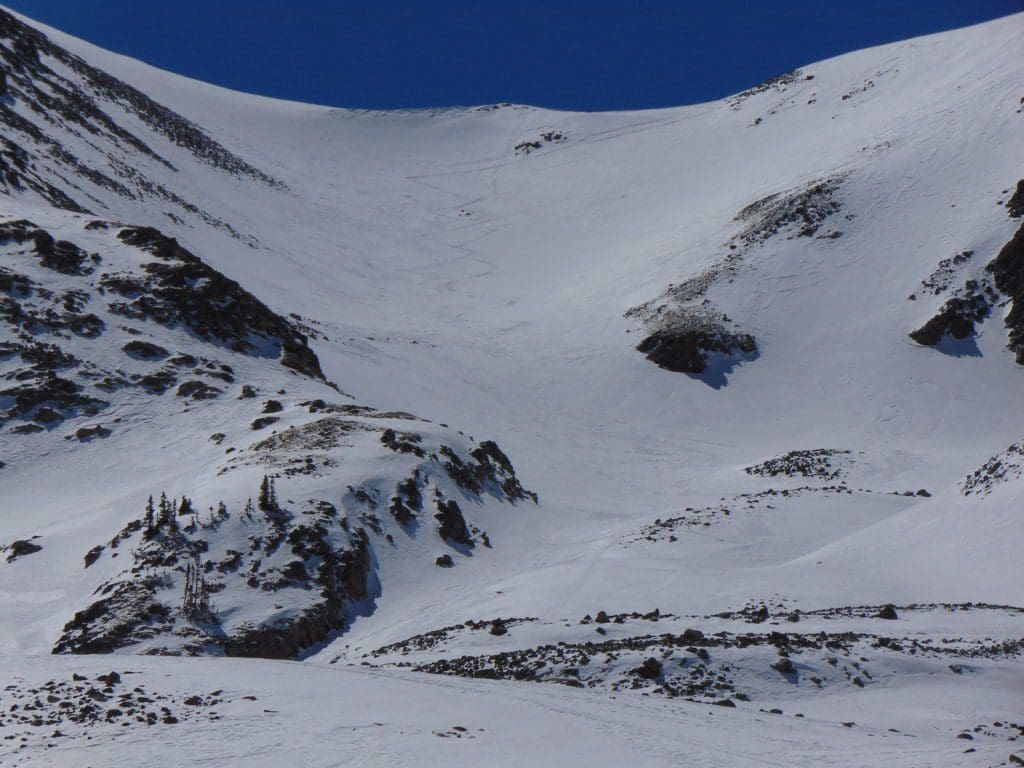
Upper Agnes Bowl, April 12, 2021.
Resorts Analysis (Snowfall averages, opening dates, and closing dates)
Once you’ve poured over the gear, planning, and weather pieces, start putting together your challenge criteria and get out there. If you don’t particularly care about finding a new backcountry line every month, focus on the resorts that not only get the most snow but stay open the longest.
As far as accumulations per season are concerned, be aware that many ski resort websites advertise a certain number of inches per season. This information, while not necessarily false, may only consider a small chunk of time, and if that chunk of time produced more or less snow than others, the “average snowfall” metric can become a little skewed. Use third-party ranking websites to determine initial estimates, then compare them to what totals resort websites report.
Below is a list of the top five snowiest resorts in Colorado using average snowfall. The first number is what’s been independently recorded by Z rankings; the second number is what the resorts list on their websites. Keep in mind that not all winters are average; there are some individual winters when many areas record over 400 inches and others where it’s much closer to 300 or even less.
- Wolf Creek: 387 inches (430 inches)
- Steamboat: 368 inches (314 inches)
- Vail: 354 inches (354 inches)
- Winter Park: 347 inches (326.9 inches)
- Loveland: 344 inches (422 inches)
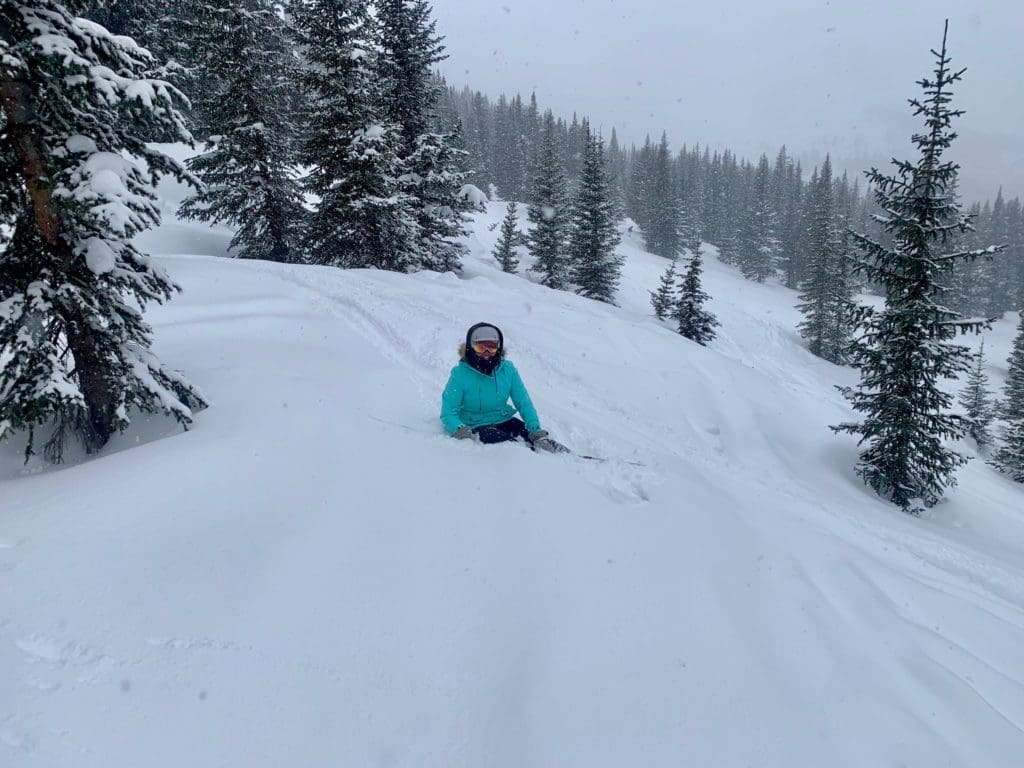
Powder in Vail’s Back Bowls.
Again, the disparity in numbers isn’t necessarily a blatant lie, but the sample sizes are different. Z rankings looks at snowfall rates from as far back as recordings are kept. Official estimates usually use either a 5- or 10-year sampling to produce their own averages.
Naturally, snowfall is only one piece of the puzzle. Resort base areas in Colorado run from 6,000 to nearly 10,800 feet above sea level. So, while Steamboat hauls in a good amount of snow, their lower base elevation means they rarely open early or stay open beyond the first or second week of April.
Below is a top-five list of earliest opening dates for Colorado resorts. Please note that all opening dates are subject to weather and conditions; this list simply represents the best chances that a resort will open at a certain time.
- Arapahoe Basin: October (usually first to open)
- Loveland: October
- Keystone: October
- Breckenridge: Early November
- Vail: Early November
- Wildcard: Wolf Creek, with good early season snow, will open weekends in October
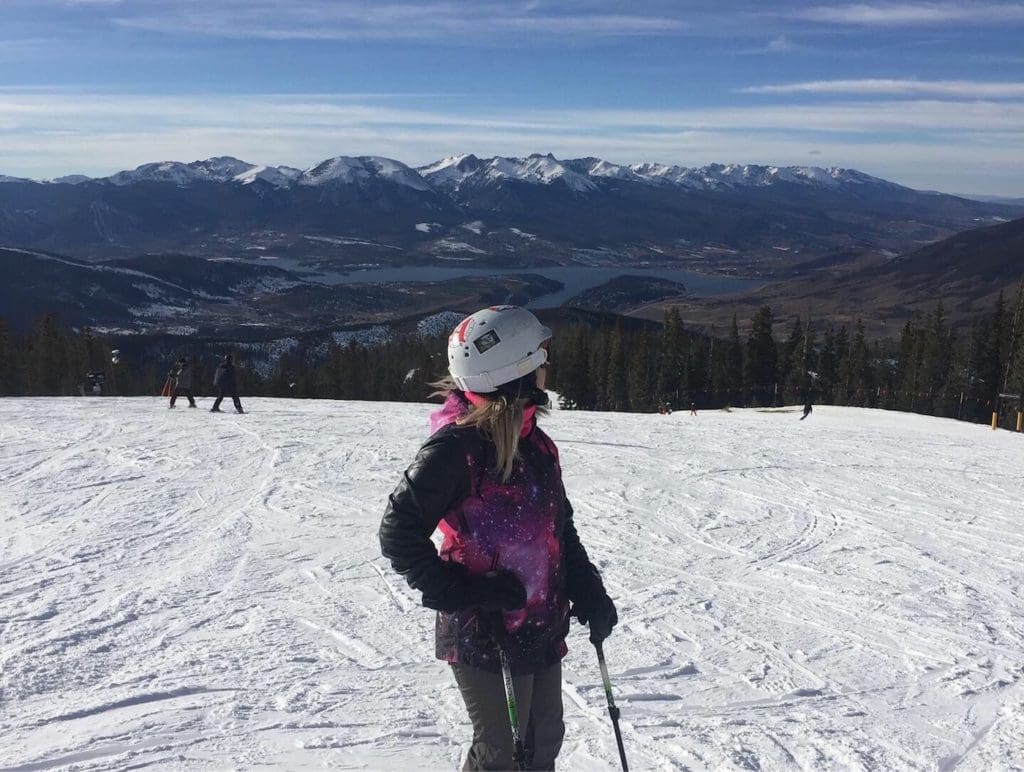
Typical early season conditions at Keystone.
Closing dates are also interesting because, like opening dates, they fluctuate wildly based on each winter. However, there are a handful of resorts that continue to make it into the early summer timeframe with high-capacity snowmaking, favorable elevation, and a decent amount of north-facing terrain (less subject to sun melt).
- Arapahoe Basin: early June (occasionally into early July, but not consistently)
- Breckenridge: Memorial Day/late May
- Loveland: early May, around the 8th
- Winter Park: variable, usually early-mid May
- Wildcard: Vail, which usually closes in mid-April, but for 2022 announced a May 1st closing, making it their longest season to date
So, what does all this mean? Well, if you want to do a ski all-year challenge but want to incorporate resorts because it’s easier, break up your season into four component pieces based on resort dates. It would look something like Autumn (Oct-Dec.), Winter (Jan-March), Spring (April-June), and Summer (July-Sept.). These pieces don’t corroborate with our historical understanding of seasons, but that understanding is stagnant and doesn’t reflect conditions on the ground. There are days in early September that can be hotter than mid-June. If you time it right, you could be resort skiing from Autumn through Spring.
So, despite not hauling in the most snow with a seasonal average around 314 inches, Arapahoe Basin is high and sheltered, meaning it holds onto snow longer. If you had to pick one resort to ski, picking the one with the longest season in Colorado makes sense. Other logical picks include Loveland, Breckenridge, Winter Park, and, occasionally, Wolf Creek.
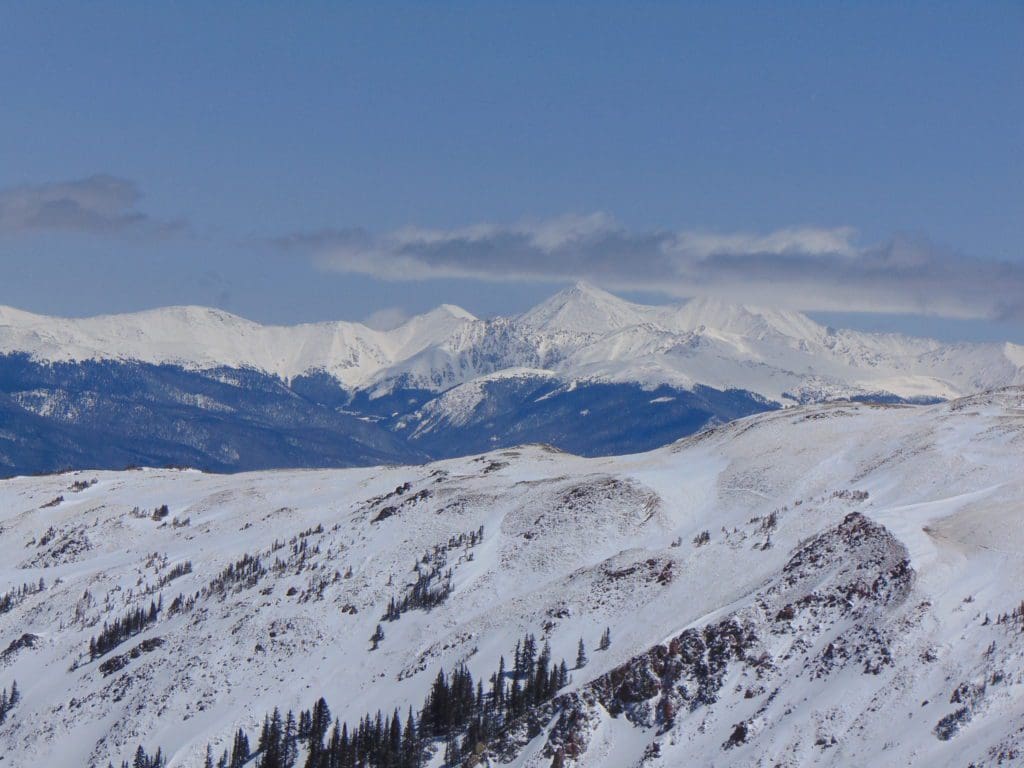
Grays and Torreys Peak after an April snowstorm.
Snowpack Stabilization and the Backcountry
For many reasons, the springtime is the perfect time to get some backcountry skiing in. As resorts begin to wind down operations, you realize how limiting their terrain can be. A storm may drop a foot of snow on the Wet mountains, for example, but there aren’t any resorts there, so you won’t be able to ski it. Backcountry opens up the possibilities, both vertically (you can ski some 14ers) and horizontally (millions of areas to explore).
The caveat to successful spring backcountry skiing is avalanche danger. Because Colorado’s snowpack is fickle and backcountry access relatively simple, it is, unfortunately, the state with the greatest risk for deadly avalanches. Snow falls in layers, each layer accompanying a storm or series of storms. How those layers interact or don’t interact does a lot to determine the likelihood of avalanches.
For example, let’s say snow falls, and then high pressure builds in, so we have a few weeks with no new accumulation. Depending on how warm it gets, the snow may partially melt during the day and refreeze at night, creating a bulletproof, icy surface. Once new snow finally falls, if it falls on an old, slippery layer, given enough force and a steep slope angle, the new snow will just slide right off of the old layer. And that’s only one of the dozens of avalanche scenarios that can occur in any given year! It’s when the snowpack stabilizes that backcountry skiing becomes less deadly.
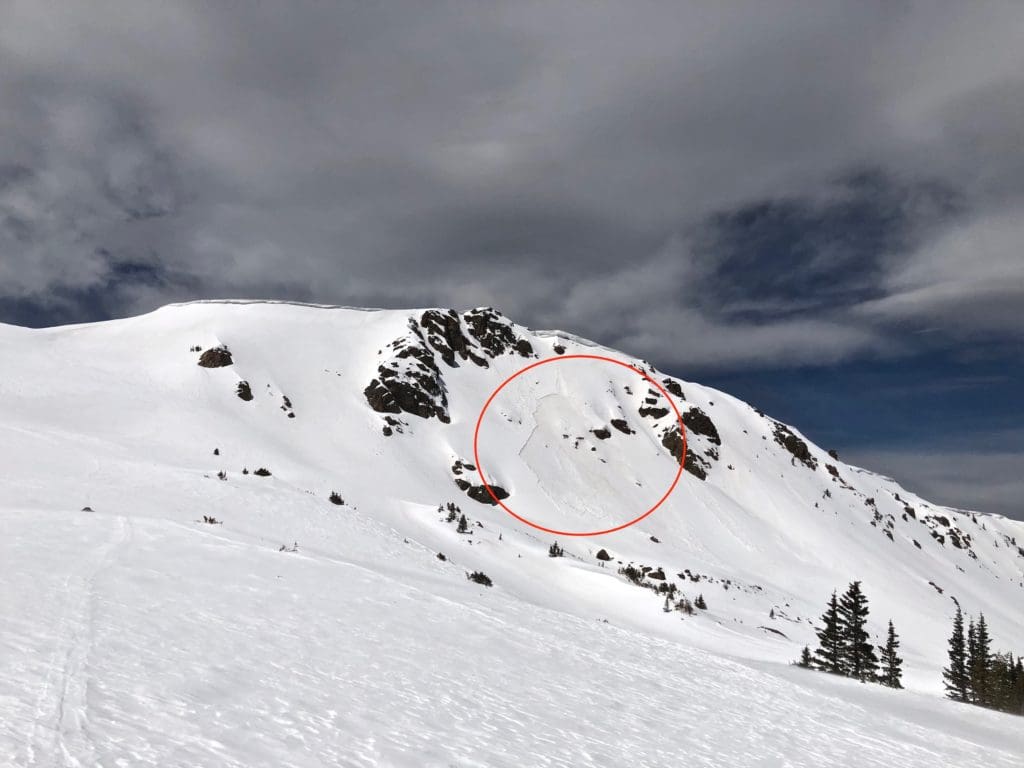
A recent avalanche on Pt. 12,089 near Vail Pass. Notice the very obvious line where the avalanche cracked, breaking off a slab of newer snow that slid over older layers.
Snowpack stabilization occurs when multiple layers of snow start bonding together. When the layers bond, aided by melt-freeze cycles, the entire snowpack acts as one cohesive unit, instead of each layer exerting its influence on others. An uneven winter can delay this process. However, in most years, by mid-late spring, the snowpack is less likely to slide.
The only way to safely assess what the snowpack is doing is to conduct field tests, which you can learn about by taking an avalanche certification (highly, highly recommended). In Colorado, we are blessed with the CAIC (Colorado Avalanche Information Center). They come out with comprehensive zone forecasts for your area, explanations for what hazards exist, where they exist, and how to avoid them. ALWAYS CHECK CAIC BEFORE BACKCOUNTRY SKIING. It could save your life.
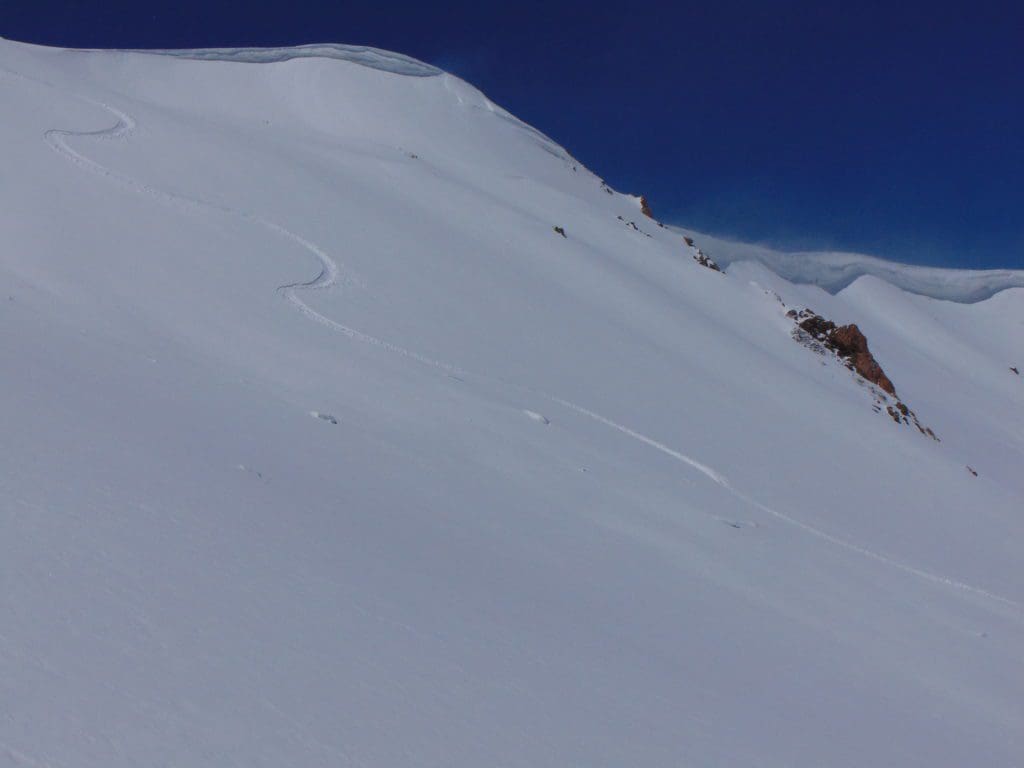
Cornices, large overhangs of snow caused by wind-loading, collapse as the weather warms, often leading to avalanches. They are invisible from certain perspectives, so give steep slopes a wide berth and try to scout all lines before attempting them.
Popular Springtime Backcountry Areas (April-June)
Assuming safer conditions and a stabilized snowpack, there are a few areas to look for during the spring that can give you some sublime backcountry skiing.
- Vail Pass East: Vail Pass is a 65,000-acre backcountry recreation area that costs $10 per day or $65 for a season pass. The season usually runs from Dec-early April; after that, it’s free to park. Since the pass lies at over 10,600 feet, you can find snow to slide on from mid-April to early June. Snowmobiles frequent the western part of the area, but if you cross the highway to Corral Creek on the east side, only human-powered recreation is allowed.
- Loveland Pass: This is likely the most popular backcountry area in Colorado for a variety of reasons: easy access, high elevation, long season, and the ability to car position to prevent having to hike out. Loveland Pass slides almost every year, and on busy spring weekends, this place is a zoo.
- Berthoud Pass: Once a ski resort, Berthoud is also an uber-popular backcountry area. There are moderate and easy lines available, but Berthoud also harbors some serious avalanche terrain, something many don’t realize because of its easy access. Pick your days wisely, and again, expect large crowds on the weekends.
- Bear Lake: Possibly the most popular area in Rocky Mountain National Park, you can find respite from the summer crowds by arriving early in the day from April to early June and on weekdays. Please check the park website for the most recent passes needed to access the park; this area is NOT free. If you do manage to get here, consider skiing the Banana Bowls, a low-angle playground that holds windblown powder up until late May.
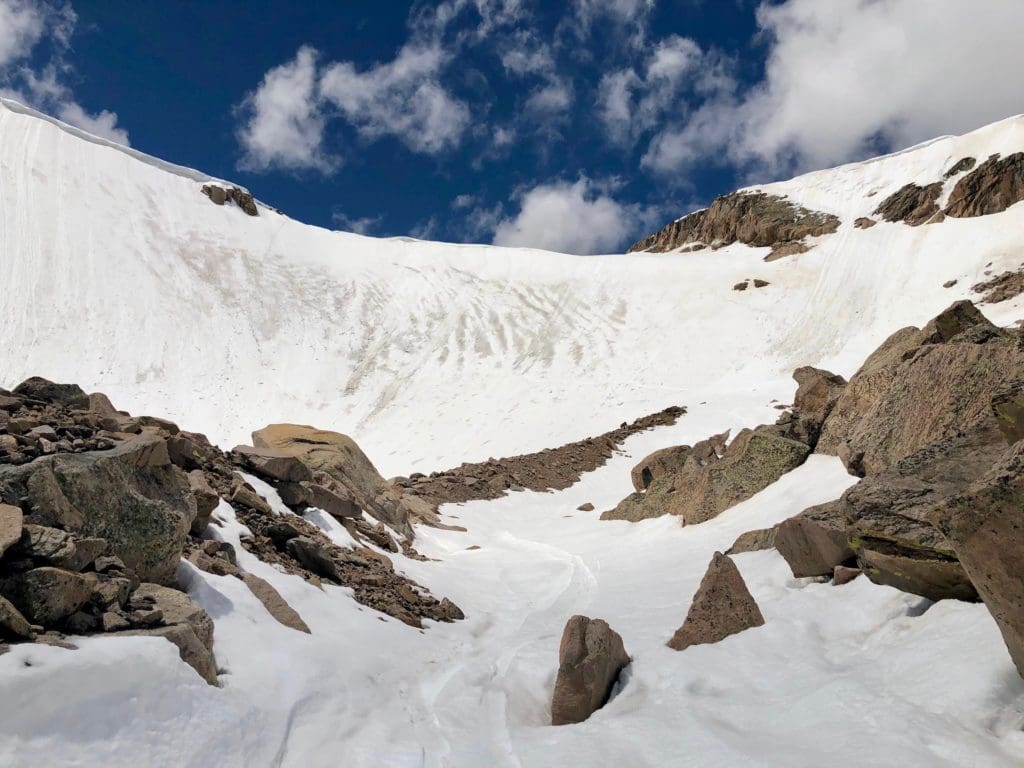
Tyndall Glacier and headwall, near Bear Lake. May 22, 2021.
- Trail Ridge: Also in Rocky Mountain National Park, this road bisects the park and features a 12-mile section above treeline. The alpine portion of the road is closed seasonally from roughly Labor Day until Memorial Day, but you can find mellow skiing at Hidden Valley before then. Once the park service opens the road, drive up to the Rock Cut area to access Sunshine Mountains’ north face, a wide, low-angle snowfield that’s skiable through most of June. Be aware that the snow continues down the side of the mountain, quickly changing from a leisurely snowfield to full-on couloir skiing. When the slope steepens, either turn around or prepare for tough skiing on variable snow.
- Quandary: Residing a few miles south of Breckenridge, Quandary is the most popular 14er in the state and can give you turns through mid-July. The Hoosier Pass Road is plowed all year, so you can get to the parking lot easily. Descending down the east ridge is the easiest option.
- Some reliable options w/ longer approaches that are usually skiable into June: Yankee Boy Basin, Red Mountain Pass, The Angel of Shavano, Africa Bowl on Mt. Massive, Mt. Sherman, Guanella Pass, Herman Gulch, the Mummy Range, Never Summers, Hallett Peak, Indian Peaks, Jones Pass, Montezuma area near Keystone, and the Gore Range.
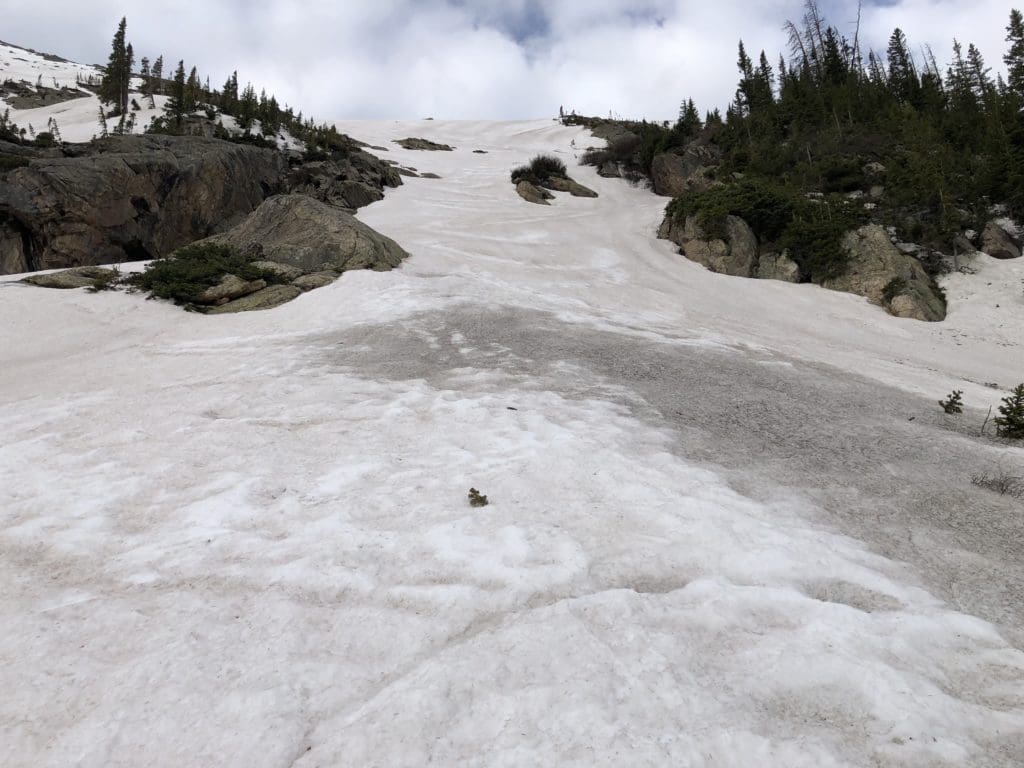
The steep, lower portion of Sundance Mountains North Face. June, 2021.
Summer Skiing
Unfortunately, there’s no way around the difficulties of summer skiing. In all likelihood, you will need to carry your skis on your pack for multiple miles both to and from whatever snowfield you choose. You may also only be stringing together a handful of turns before the snow runs out or turns into a dangerous rock dodging mess. The most difficult part of the challenge occurs during this window.
Avalanche danger from July-September is virtually non-existent, but that doesn’t mean there aren’t hazards. If you’re in a steep area, you’ll be trading avalanche concerns for rock concerns. The Rocky Mountains are eroding bit by bit every year, and rapid snowmelt, strong winds, or torrential downpours can all lead to mud or rock slides. Complicating the narrative is the slow heating of the planet, which has reduced your workable options to snowfields that generally hide in hard-to-reach mountain pockets.
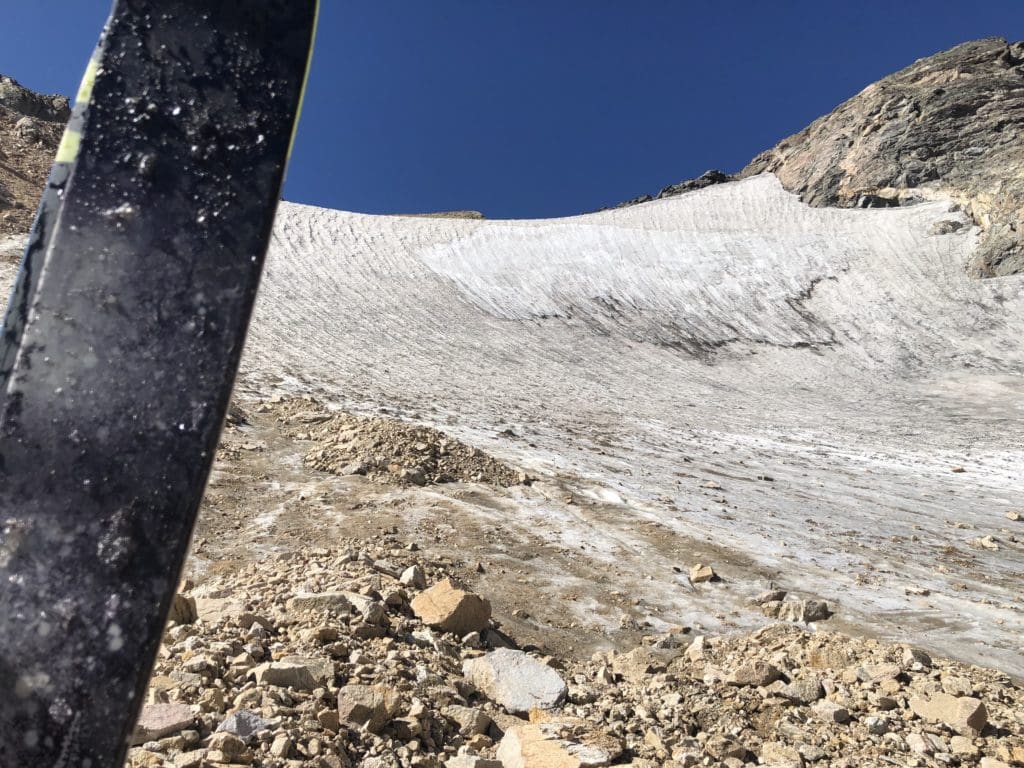
Ptarmigan Glacier, August 25, 2021. The manageable top half gives way to a pot marked mess, with rocks all over the place.
Despite the challenges, there are a handful of reliable options that can support turns without putting you directly into the crosshairs of danger.
- St Mary’s Glacier: A bit misleading since it isn’t a glacier anymore, St. Mary’s has reliable snow through early August. During some hot and dry years, all of the snow melts, but during good years, the snowfield will last all year. Plan on being able to ski through July/early August, but don’t count on September.
- Skyscraper Glacier: Like St. Mary’s, Skyscraper is not an actual glacier, but unlike St. Mary’s, the snow on Skyscraper stays around all year. Best accessed via the Corona Pass (aka Rollins Pass) road near Winter Park; this steep snowfield can give you turns all year. Be prepared to hike back out of the drainage at the bottom and know that by September, the entrance is nearly vertical before the slope angle lessens.
- Andrews Glacier: This actual alpine glacier (defined as a cohesive piece of ice that advances and retreats throughout the year) can give you turns all year. The hike to it is not insignificant, a journey of more than four miles each way with substantial elevation gain, but it’s worth it. The glacier is in Rocky Mountain National Park, so check those passes, or you cannot enter. The glacier runs for several hundred feet, has a great slope angle in the mid-20s, and is connected to the tarn at its base through the end of July. It is at its smallest in September/early October before the first round of accumulating snowfall hits the high country.
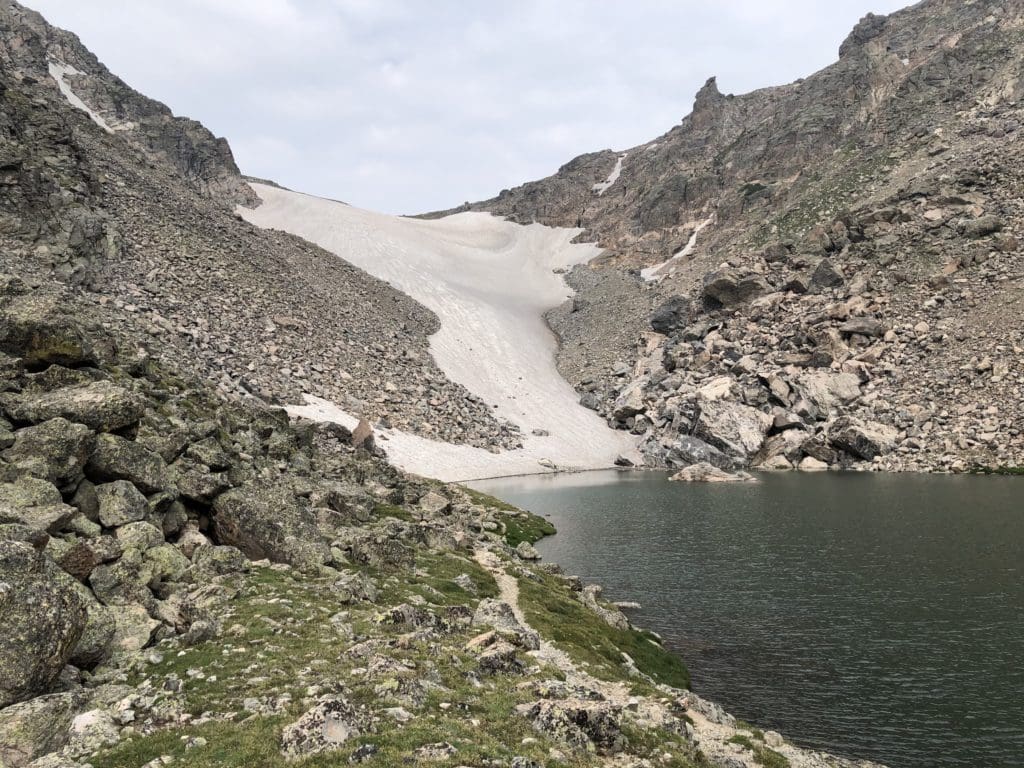
Andrews Glacier, still connected to the tarn at its base on July 25th. By early Autumn, the glacier retreats above the tarn.
- Isabelle Glacier: Another permanent snowfield; Isabelle has experienced some significant snow loss over the years but still has enough mass to grant you turns throughout the year. The approach is long but on an easy-to-follow trail, and the skiing is relatively low angle. This is also a fee area so check the latest prices and rules here.
- Evans/Mt. Blue Sky. This is the closest 14er to Denver and has a road all the way to within a few feet of the summit. Snow tends to linger in some of the cirques on the mountain well into summer, but a warm summer can dry it all out. This is NOT a free area; check prices before going.
- Some harder options: Taylor Glacier, Tyndall Glacier, Navajo snowfield, Ptarmigan Glacier, Sprague Glacier, St. Vrain Glaciers, Mt. Neva, any of the roughly 100 permanent snowfields left in the state. Use mapping software with satellite imagery to hunt for snow patches on northerly or easterly terrain high up on the state’s taller peaks.
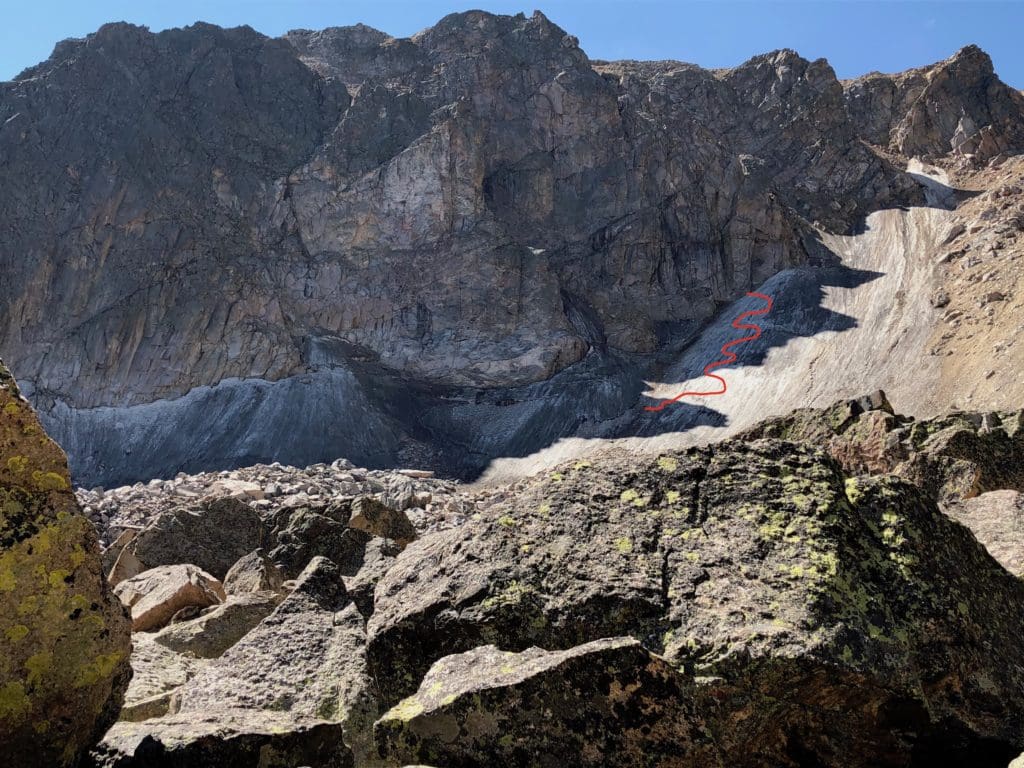
Dirty, rocky and dangerous, the Knobtop Icefield on Sept. 16, was a practice in risk management. My turns are drawn in.
Autumn Skiing
While you could make a fairly convincing argument that September is the toughest month of the challenge, Autumn is not without its fair share of hazards. Generally, October signals the return of high elevation snowfall, but that isn’t a guarantee that it’ll be enough to ski on. Additionally, a fresh dump of snow will help conceal hazards, but it often won’t be enough to ski over without destroying your skis. You need multiple feet of snow to render these hazards a non-issue. So, if an autumn storm drops some good snow, go high, scout for lower angle slopes, and stay out of the trees until there’s enough accumulation.
Here are some possible October options if you’re itching to get out.
- The permanent snowfields and glaciers listed above are going to be the most reliable options (St. Mary’s on a good year, Andrews, Isabelle, and Skyscraper if the road is passable). Again, there may be over 100 permanent snowfields hiding in the mountains; finding them is up to you. A good strategy is to embrace high-elevation summer hiking and take note of anywhere you see a substantial patch of leftover snow.
- Berthoud Pass and Loveland Pass. While not guaranteed, these areas are known for being some of the earlier recipients of autumn snow.
- Coon Hill near the Eisenhower/Johnson Tunnel, provided there is enough snow.
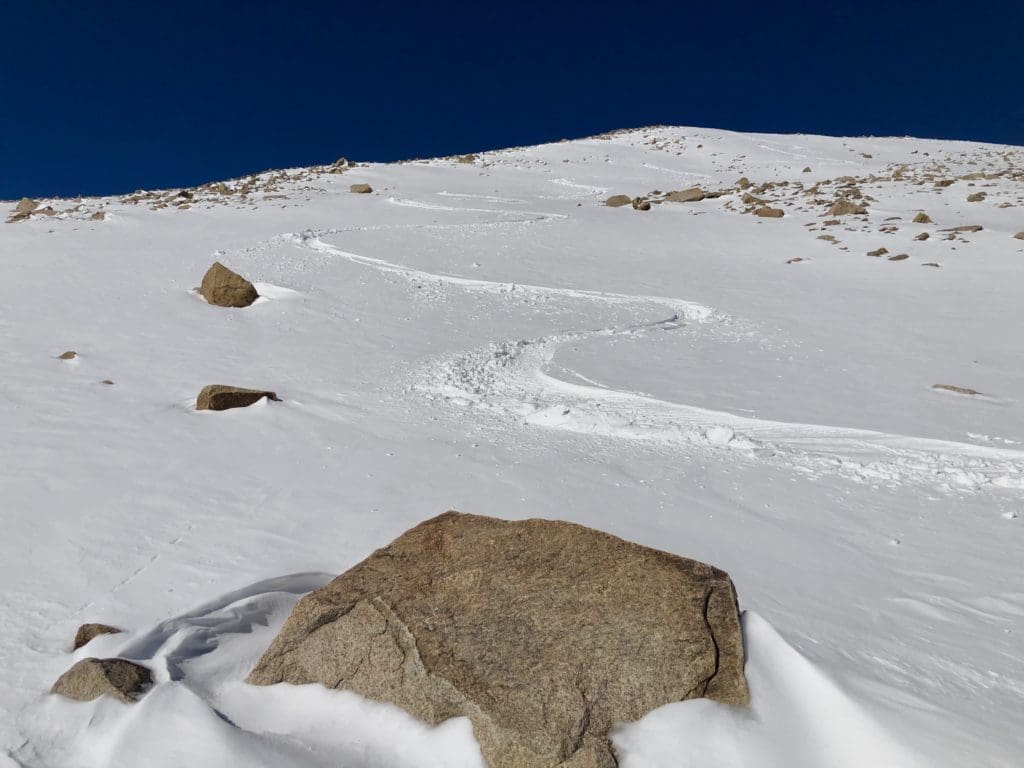
Thin snowpack skiing in November.
- Guanella Pass/Mt. Bierstadt. Guanella Pass is a paved, seasonal road but won’t close until mid-late November, which means it can provide you high elevation access to the slopes of the gentle 14er, Mt. Bierstadt, or any number of tall 13ers on the west side of the pass.
- Shrine Pass Road, near Vail Pass. The road is dirt and has a low angle, but its position on the western slope means it can haul in autumn snow. A foot of accumulation and a few freezes overnight can give you a few hundred vertical feet of skiing.
- Loveland Ski Area or Arapahoe Basin ski area. The resorts usually open in October.
- Wildcard: Wolf Creek. It doesn’t happen every year, but occasionally Wolf Creek and the terrain surrounding Wolf Creek Pass can haul in some substantial early season snow.
- Even during drier than normal years, ski resorts have the snowmaking capacity to open by November. October is the wildcard month, but holding a few permanent snowfield options in your quiver can help you bridge the seasons.
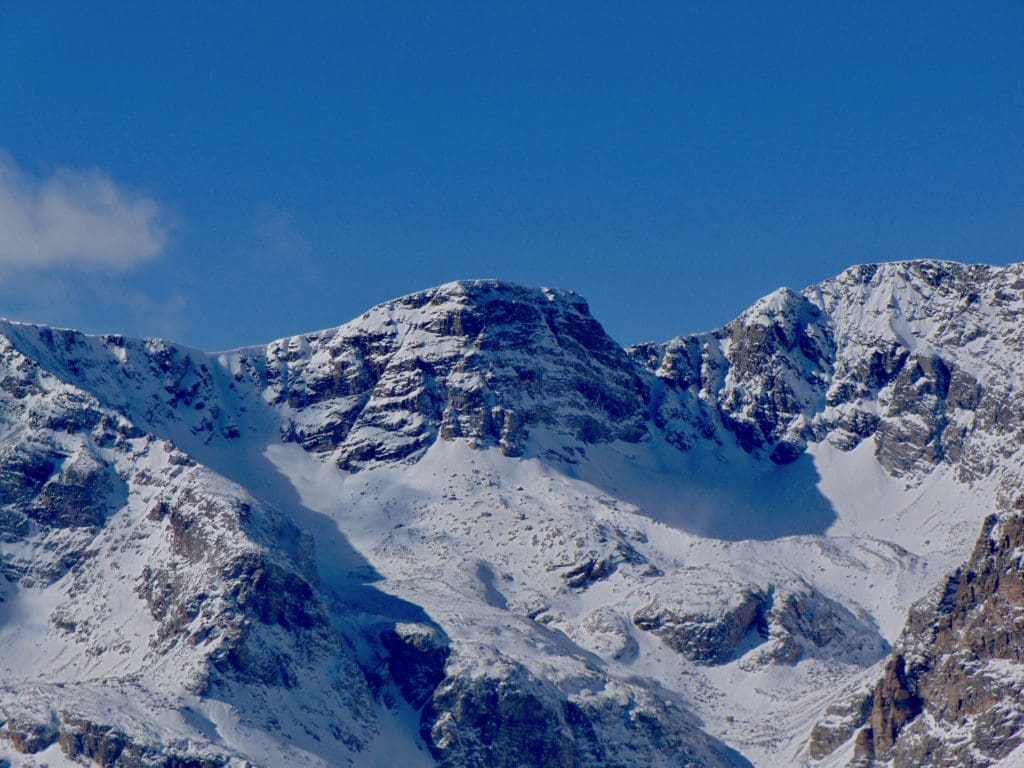
The terrain around the remote and hard-to-reach, but still free, St. Vrain Glaciers.
Tips and Tricks for Fee Areas
Look, Colorado is popular, and the most popular areas are being inundated by tourists and locals alike. In an effort to stymie rampant degradation of sensitive alpine environments, the forest service set up a timed entry and pass system for a lot of areas. Unfortunately, these areas harbor some of the easiest to access permanent snowfields and cirque glaciers. You have to travel far away from the Front Range to shake the costs unless you hit Skyscraper Glacier all year or are ok with demanding approach hikes.
- Mary’s has a $5 parking fee.
- Anything in Rocky Mountain National Park will cost you. The best bet is to get an America the Beautiful Year Pass. Even armed with a pass, you still have to deal with the timed entry system, get online, and reserve a spot. The only workaround is to have an entrance pass and make it beyond the Bear Lake Road station by 5 am or get onto Trail Ridge by 9 am to avoid the timed entry component.
- Brainard Lake Recreation Area (Indian Peaks access). The area is popular for a reason, and you will be ticketed if you don’t pony up. Buy passes and timed entries online. According to the official site, there is no freebie entry for getting into the area early. An America the Beautiful Pass will work for both the National Park and Brainard, but for Brainard, you need to pay the 2$ timed entry fee on top of it. Before the summer gate opens, you can park at the winter gateway trailhead for free.
- Mt. Evans/Blue Sky. It’s a long way into Mt. Evans without taking the road, you could possibly climb over the Sawtooth from Guanella, but that is a huge effort with skis on your back. Visit the website and set up a time in advance. Most years, the snow here is gone by September.
- This is an old paper that goes in-depth on various snowfields and glaciers left in Colorado. Please note that the information may be incomplete, and it’s more than 10 years old; some of the ice fields probably don’t exist anymore. However, if you have a strong aversion to paying fees and don’t mind brutal approaches, see if some of the snowfields in the Medicine Bow, San Miguel, Park, Gore, and Sawatch Ranges can scratch the skiing itch.
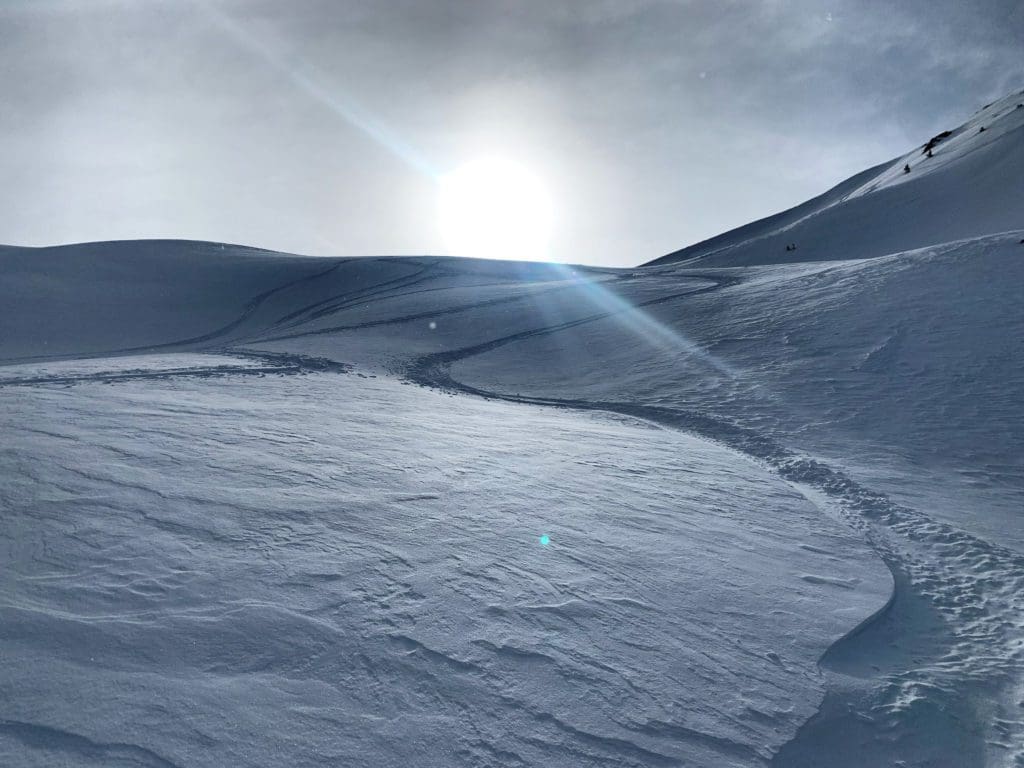
Early December snow on the western slope.
Why would anyone do this?
Ah, yes, the reasons. Well, it’s not an unfair question, though the answer depends entirely on who you ask. For me, it came down to a few reasons that I think resonate fairly strongly with those pulled to the outdoors.
I had mastered the craft of resort skiing over decades of training and years of instructing, so I was looking for a new challenge. I also liked the creativity and self-sufficiency involved with backcountry skiing, the solitude, and the freedom to pursue an outdoor challenge in any way that I chose. I’m also a realist, and realistically, you won’t be able to ski all year in Colorado forever.
The summer options are fading slowly into the talus and scree, taking with them your chances to complete this kind of adventure. Will it happen overnight? No, clearly not, and a lot of the doom and gloom talk hasn’t quite translated to reality. But the long-term trends are hard to ignore, especially if, like me, you spent seven years working at a ski resort. 2100 is going to look a lot different than the 2020s. Get it while it’s there.
For me, it certainly wasn’t an activity that I took up quickly. This was a methodical and planned adjustment from resort skiing to backcountry and took years to commit to. Rash decisions and spontaneity aren’t qualities you want to bring to any dangerous activity. There are many things you can control in your prep and planning but ultimately, the mountains dictate when and where you can play. The minute you convince yourself that dynamic doesn’t exist is the minute you invite unnecessary risk in, and once you do, it’s hard to cage those dangerous tendencies.
For the few that choose to make turns all year, the rewards always trump the difficulties. But it is critical to understand that you will be working hard to get those summer and early autumn lines. It wouldn’t be a challenge if it was easy.
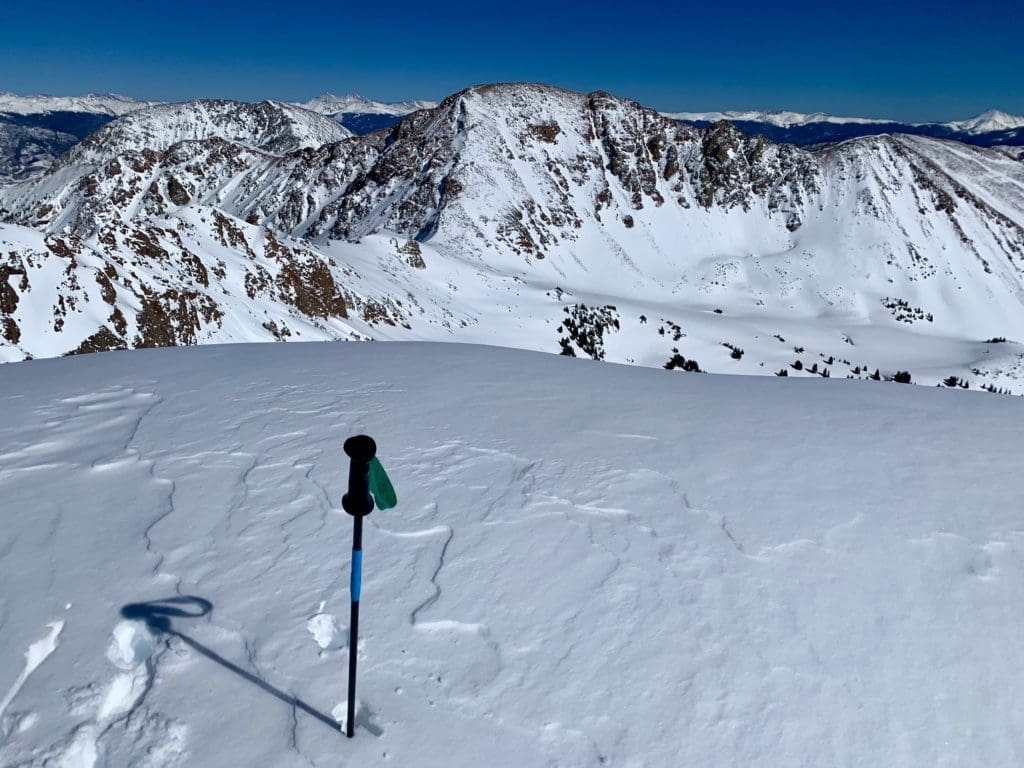
A sea of mountains awaits.
Final Thoughts
Well, there you have it, some information to get you started. The reliable summer options are all permanent snowfields and alpine glaciers, the most well-known of which reside north of Berthoud Pass in the Front Range, where pay-to-play areas are common. There are plenty of additional permanent snowfields on 14ers and 13ers, but getting to them is up to you.
My journey began with a February 2021 adventure down the Minturn Mile, one of the most famous sidecountry runs in the state and has continued to this day. My first year on the journey is listed below. If you’re interested in what others have skied, I’ve included some additional information and resources below. Enjoy the snow while it’s there, and always, always put safety first.
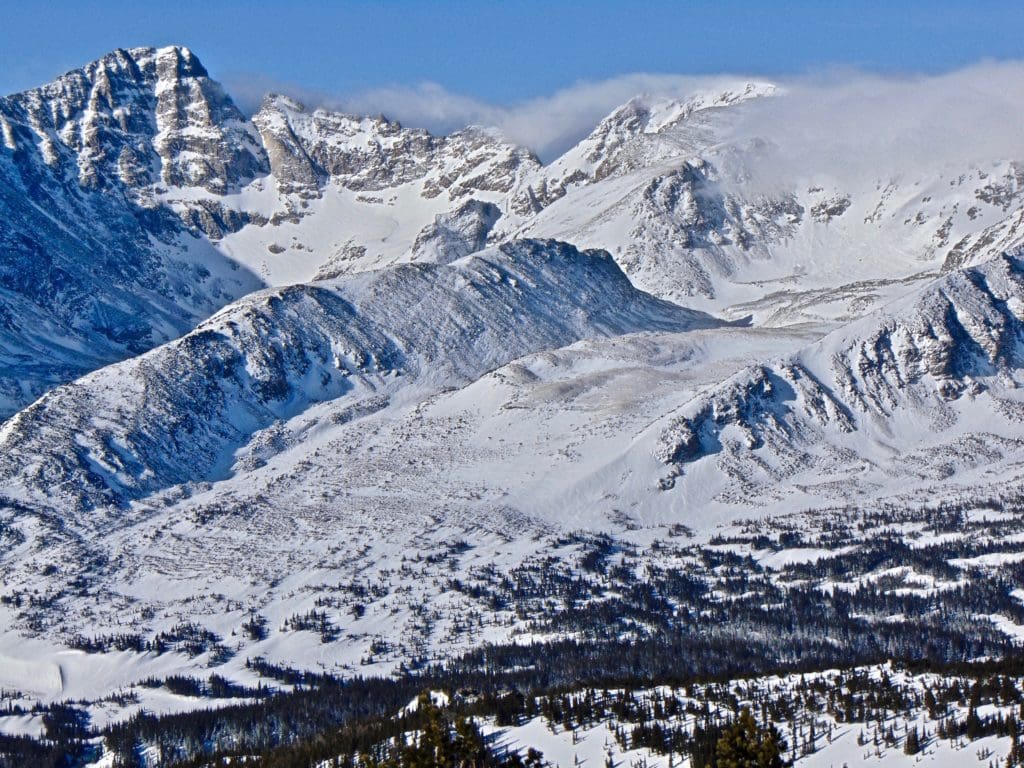
The northern Continental Divide in late March.
Here’s a listing of my monthly ski trips so far:
- February 2021: Minturn Mile
- March 2021: Pawnee Pk. SE Slopes
- April 2021: Vail Pass East: Uneva North (Couloir 2)
- May 2021: Tyndall Glacier: RMNP
- June 2021: Sundance North Face: RMNP
- July 2021: Andrews Glacier: RMNP
- August 2021: Ptarmigan Glacier: RMNP
- September 2021: Knobtop Icefield: RMNP
- October 2021: Shrine Pass Meadows (Vail Pass West)
- November 2021: Mt. St. Vrain-south slopes direct
- December 2021: Vail Pass East-Saddle Run N.
- January 2022: Banana Bowls: RMNP
Additional Resources
Arapahoe Basin. (n.d.). A-Basin by the Numbers. Retrieved April, 2022, from https://www.arapahoebasin.com/the-mountain/winter-101/
CAIC (Colorado Avalanche Information Center). (n.d.). Retrieved April, 2022, from https://www.avalanche.state.co.us/
Front Range Ski Mountaineering. (n.d.). Retrieved April 5, 2022, from https://www.frontrangeskimo.com/
Gratz, Joel. (2022). Colorado Daily Snow. Opensnow. Retrieved April, 2022, https://opensnow.com/dailysnow/colorado
Hoffman, M. Glaciers of Colorado (2009). Retrieved April, 2022, from https://glaciers.us/glaciers.research.pdx.edu/glaciers-colorado-2.html
Loveland Ski Area. (n.d.). Trail Map & Mountain Stats. Retrieved April, 2022, from https://skiloveland.com/the-mountain/trail-map-mountain-stats/
Morrissey, T. (n.d.). Skiing all year round. Spring, Summer, Fall, Winter. Turns all year, Year 4 in Colorado. YouTube. Retrieved April 5, 2022, from https://www.youtube.com/?gl=NL
Steamboat. (n.d.). Mountain Stats. Retrieved April, 2022, from https://www.steamboat.com/the-mountain/mountain-stats
The Road West Traveled. (n.d.). Turns all year | full film – youtube. Youtube. Retrieved April 5, 2022, from https://www.youtube.com/watch?v=G6oW3M4kwao
Vail. (n.d.). Mountain Information. Retrieved April, 2022, from
https://www.vail.com/the-mountain/about-the-mountain/mountain-info.aspx
Winter Park Resort. (n.d.). Mountain Information. Retrieved April, 2022, from https://www.winterparkresort.com/the-mountain/mountain-information/statistics
Wolf Creek. (n.d.) Wolf Creek Stats & Facts. Retrieved April, 2022, from https://wolfcreekski.com/wolf-creek-stats-facts/
Z Rankings. (n.d.) Best Snow in Colorado – Right Now and Historically. Retrieved April, 2022, from https://www.zrankings.com/articles/best-snow-in-colorado
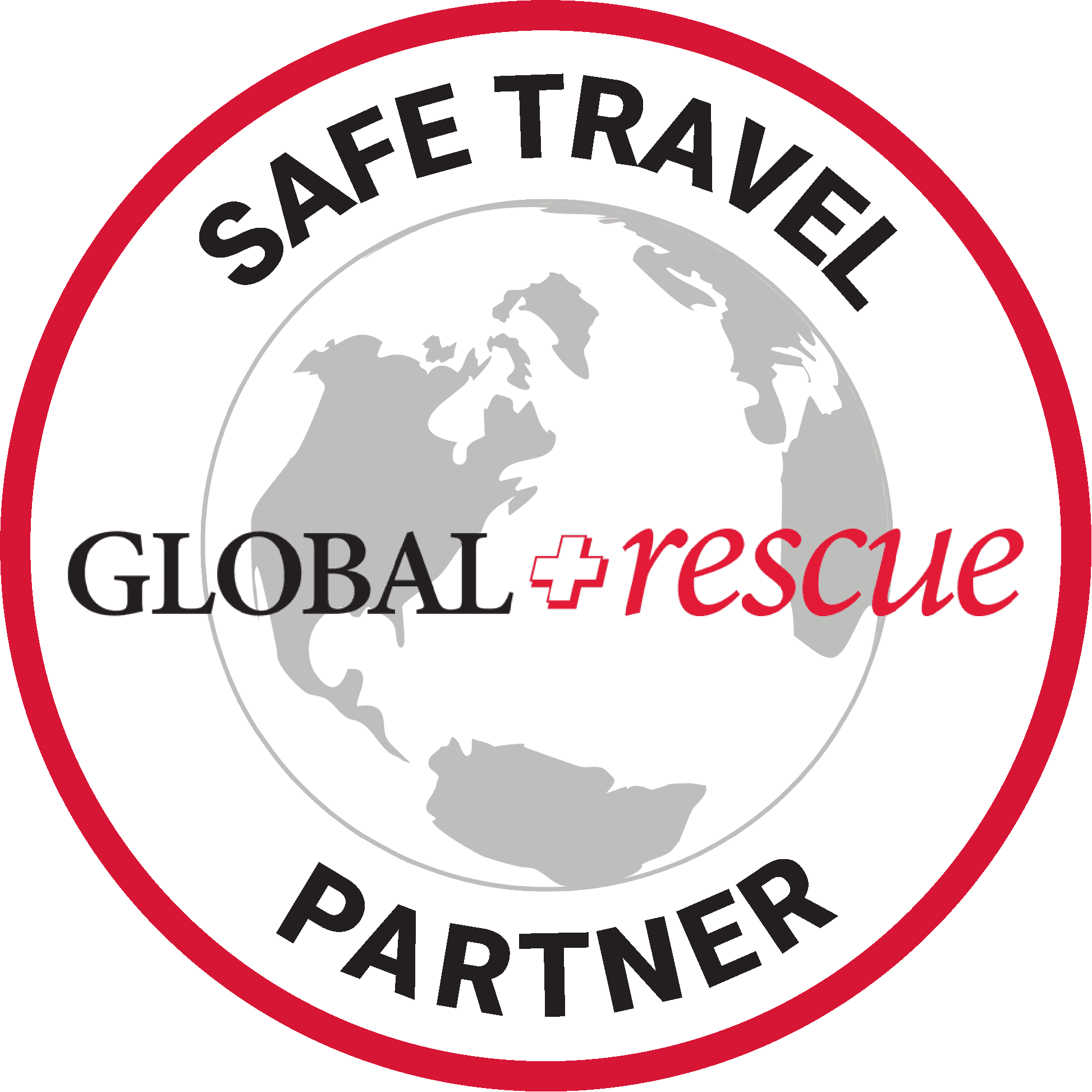
Skyblue Overland Strongly Recommends That You Enroll With Global Rescue Prior To Embarking On Your Next Adventure.
With more people outside now more than ever, Global Rescue expanded services to include field rescue within 100 miles of home. With Local Field Rescue — automatically included in any travel protection services membership — Global Rescue is there whether you’re hiking, kayaking, snowmobiling, fishing or simply enjoying the outdoors and get ill or injured and you’re unable to get to safety on your own.
Purchase a Global Rescue membership for your next adventure and travel with peace of mind. Single trip, annual and family options are available.









